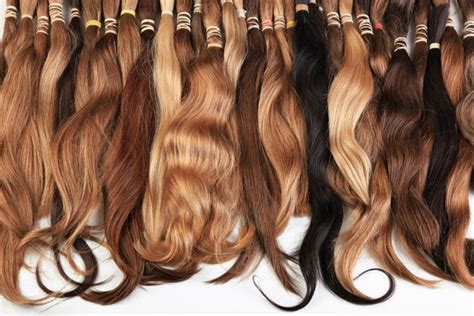Introduction
Hair extensions have become increasingly popular among individuals seeking to transform their appearance, enhance their hair volume, and experiment with different styles. Human hair extensions, derived from real human hair, offer a natural and seamless blend with one’s own hair, making them highly desirable. This article will provide a comprehensive guide to human hair extensions, covering everything from their benefits and types to their application and maintenance.

Benefits of Human Hair Extensions
- Natural Appearance: Human hair extensions are indistinguishable from natural hair, both in texture and luster. They mimic the natural hair growth patterns and movement, providing a seamless and undetectable enhancement.
- Versatility: Human hair extensions are incredibly versatile, allowing for a wide range of styling options. They can be curled, straightened, colored, or cut to match your desired look.
- Long-Lasting: With proper care and maintenance, human hair extensions can last up to a year or more. Their durability makes them a worthwhile investment for those seeking long-term enhancements.
- Flexibility: Human hair extensions can be customized to fit your specific needs. They are available in various lengths, textures, and colors, ensuring a perfect match for your hair and desired style.
- Damage Reduction: Human hair extensions can help protect your natural hair from damage caused by heat styling, chemical treatments, and environmental factors. They provide an extra layer of hair that absorbs heat and shields your own strands from harsh elements.
Types of Human Hair Extensions
There are three main types of human hair extensions:
- Remy Hair: This type of hair is collected from a single donor, ensuring the cuticle layer remains intact. Remy hair extensions have minimal tangling and matting, resulting in a smooth and silky feel.
- Non-Remy Hair: Non-Remy hair comes from multiple donors, and the cuticles are not aligned in the same direction. While it is more affordable than Remy hair, it may be more prone to tangling and shedding.
- Virgin Hair: Virgin hair refers to hair that has not been chemically treated or colored. It is the highest quality of human hair extensions and offers the most natural appearance and durability.
Choosing the Right Human Hair Extensions
Selecting the right human hair extensions depends on your hair type, desired length, and budget. Consider the following factors when making your choice:
- Hair Texture: Human hair comes in different textures, including straight, wavy, curly, and kinky. Match the texture of your extensions to your natural hair for a cohesive look.
- Hair Length: Hair extensions are available in various lengths, ranging from a few inches to over 20 inches. Choose the length that will complement your own hair length and desired style.
- Hair Color: Human hair extensions are available in a wide range of colors, from natural shades to vibrant hues. Choose a color that matches your natural hair color or experiment with new shades for a bold statement.
- Budget: Human hair extensions can vary in price depending on the type of hair, length, and quality. Determine your budget and research different options to find the best fit.
Application Methods
There are two main methods for applying human hair extensions:
- Keratin Bonds: Keratin bonds are used to attach the extensions to your natural hair using heat and a bonding agent. This method is semi-permanent and can last up to six months.
- Tape-In Extensions: Tape-in extensions are applied by using double-sided tape to secure the extensions to your natural hair. They are less permanent than keratin bonds and can be removed or repositioned at any time.
Maintenance
Proper maintenance is essential to ensure the longevity and quality of your human hair extensions. Follow these tips for optimal care:
- Wash and Condition: Wash your extensions regularly with sulfate-free shampoo and conditioner designed for hair extensions. Avoid using hot water and excessive brushing.
- Detangling: Gently detangle your extensions using a wide-tooth comb or brush. Start from the ends and work your way up to prevent breakage.
- Styling: Use heat protectant spray before styling your extensions with heat tools. Limit the use of high heat to avoid damage.
- Avoiding Chlorine and Saltwater: Chlorine and saltwater can damage human hair extensions. Wear a swim cap or apply a leave-in conditioner to protect them when swimming.
- Avoid Excessive Bleaching: Chemical treatments like bleaching can weaken human hair extensions. Limit the use of bleach and consult with a professional stylist for guidance.
Common Problems and Solutions
- Tangling: Tangling can occur due to improper brushing or styling. Use a detangling spray and gently comb through the extensions to remove any knots.
- Shedding: Some shedding is normal, but excessive shedding can indicate poor quality or improper application. Contact your stylist for professional assistance.
- Matting: Matting occurs when extensions become tangled and matted together. Avoid sleeping with wet extensions and gently detangle them with a wide-tooth comb to prevent matting.
- Damage: Human hair extensions can become damaged by excessive heat styling, chemical treatments, or improper care. Use heat protectant spray, limit the use of high heat, and follow proper maintenance instructions to minimize damage.
Conclusion
Human hair extensions offer a versatile and natural way to enhance your hair’s volume, length, and style. By choosing the right type of extensions, applying them properly, and maintaining them carefully, you can enjoy beautiful, healthy-looking hair for months to come. Whether you desire a subtle enhancement or a dramatic makeover, human hair extensions empower you to transform your appearance and express your individual style.
